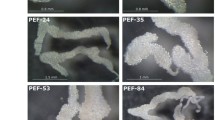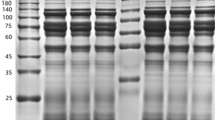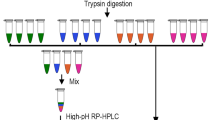Abstract
Haemaphysalis longicornis is an ixodid tick that can spread a wide variety of pathogens, affecting humans, livestock and wildlife health. The high reproductive capability of this species is initiated by the ingestion of a large amount of blood ingested by the engorged female tick. The degree of ovarian development is proportional to the number of eggs laid. Studying the regulatory mechanism of tick ovary development is relevant for the development of novel tick control methods. In this study, we used quantitative proteomics to study the dynamic changes in protein expression and protein phosphorylation during ovarian development of engorged female H. longicornis ticks. Synergistic action of many proteins (n = 3031) is required to achieve ovarian development and oocyte formation rapidly. Through bioinformatics analysis, changes in protein expressions and phosphorylation modifications in regulating the ovarian development of female ticks are described. Many proteins play an essential role during ovarian development. Also, protein phosphorylation appeared an important reproductive strategy to enable ticks to efficiently convert large amounts of blood in the ovaries into egg-producing components and ultimately produce many eggs.








Similar content being viewed by others
References
Abreu LA, Valle D, Manso PP, Façanha AR, Pelajo-Machado M, Masuda H, Vaz I Jr, Lenzi H, Oliveira PL, Logullo C (2004) Proteolytic activity of Boophilus microplus yolk pro-Cathepsin D (BYC) is coincident with cortical acidification during embryogenesis. Insect Biochem Mol Biol 34:443–449
Bartíková P, Holíková V, Kazimírová M, Štibrániová I (2017) Tick-borne viruses. Acta Virol 61:413–427
Beere HM, Wolf BB, Cain K, Mosser DD, Mahboubi A, Kuwana T, Tailor P, Morimoto RI, Cohen GM, Green DR (2000) Heat-shock protein 70 inhibits apoptosis by preventing recruitment of procaspase-9 to the Apaf-1 apoptosome. Nat Cell Biol 2:469–475
Boulangé A, Serveau C, Brillard M, Minet C, Gauthier F, Diallo A, Lalmanach G, Authié E (2001) Functional expression of the catalytic domains of two cysteine proteinases from Trypanosoma congolense. Int J Parasit 31:1435–1440
Bown DP, Wilkinson HS, Gatehouse JA (1998) Midgut carboxypeptidase from Helicoverpa armigera (Lepidoptera: Noctuidae) larvae: enzyme characterization, cDNA cloning and expression. Insect Biochem Mol Biol 28:739–749
Breddam K (1986) Serine carboxypeptidases. A review. Carlsberg Res Commun 51:83
Brzostowski JA, Fey P, Yan J, Isik N, Jin T (2009) The Elmo family forms an ancient group of actin-regulating proteins. Commun Integr Biol 2:337–340
Cabrera AR, Donohue KV, Roe RM (2009) Regulation of female reproduction in mites: a unifying model for the Acari. J Insect Physiol 55:1079–1090
Castro-Gomes T, Corrotte M, Tam C, Andrews NW (2016) Plasma membrane repair is regulated extracellularly by proteases released from lysosomes. PLoS ONE 11:e0152583
Cayol C, Koskela E, Mappes T, Siukkola A, Kallio ER (2017) Temporal dynamics of the tick Ixodes ricinus in northern Europe: epidemiological implications. Parasit Vectors 10:166
Chinzei Y, Chino H, Takahashi K (1983) Purification and properties of vitellogenin and vitellin from a tick, Ornithodoros moubata. J Comp Physiol B 152:13–21
Cho WL, Deitsch KW, Raikhel AS (1991) An extraovarian protein accumulated in mosquito oocytes is a carboxypeptidase activated in embryos. Proc Natl Acad Sci USA 88:10821–10824
Coons LB, Lamoreaux WJ, Roselldavis R, Tarnowski BI (1989) Onset of vitellogenin production and vitellogenesis, and their relationship to changes in the midgut epithelium and oocytes in the tick Dermacentor variabilis. Exp Appl Acarol 6:291–305
de la Fuente J (2018) Controlling ticks and tick-borne diseases looking forward. Ticks Tick Borne Dis 9:1354–1357
Estrela AB, Seixas A, Teixeira Vde O, Pinto AF, Termignoni C (2010) Vitellin- and hemoglobin-digesting enzymes in Rhipicephalus (Boophilus) microplus larvae and females. Comp Biochem Physiol B 157:326–335
Fagotto F (1991) Yolk degradation in tick eggs-III: Developmentally regulated acidification of the yolk spheres. Dev Growth Differ 33:57–66
Fagotto F (1995) Regulation of yolk degradation, or how to make sleepy lysosomes. J Cell Sci 108:3645–3647
Frank D, Vince JE (2019) Pyroptosis versus necroptosis: similarities, differences, and crosstalk. Cell Death Differ 26:99–114
Giorgi F, Bradley JT, Nordin JH (1999) Differential vitellin polypeptide processing in insect embryos. Micron 30:579–596
Gomes CB, Silva FS, Charret KD, Pereira BA, Finkelstein LC, Santos-de-Souza R, de Castro Côrtes LM, Pereira MC, de Oliveira R, Jr FO, Alves CR (2017) Increasing in cysteine proteinase B expression and enzymatic activity during in vitro differentiation of Leishmania (Viannia) braziliensis: first evidence of modulation during morphological transition. Biochimie 133:28–36
Grimsley CM, Kinchen JM, Tosello-Trampont AC, Brugnera E, Haney LB, Lu M, Chen Q, Klingele D, Hengartner MO, Ravichandran KS (2004) Dock180 and ELMO1 proteins cooperate to promote evolutionarily conserved Rac-dependent cell migration. J Biol Chem 279:6087–6097
Guo W, Wu Z, Yang L, Cai Z, Zhao L, Zhou S (2019) Juvenile hormone-dependent Kazal-type serine protease inhibitor Greglin safeguards insect vitellogenesis and egg production. FASEB J 33:917–927
Hawkins LJ, Wang M, Zhang B, Xiao Q, Wang H, Storey KB (2019) Glucose and urea metabolic enzymes are differentially phosphorylated during freezing, anoxia, and dehydration exposures in a freeze tolerant frog. Comp Biochem Physiol Part D 30:1–13
James AM, Oliver JH Jr (1997) Purification and partial characterization of vitellin from the black-legged tick, Ixodes scapularis. Insect Biochem Mol Biol 27:639–649
Khalil SM, Donohue KV, Thompson DM, Jeffers LA, Ananthapadmanaban U, Sonenshine DE, Mitchell RD, Roe RM (2011) Full-length sequence, regulation and developmental studies of a second vitellogenin gene from the American dog tick, Dermacentor variabilis. J Insect Physiol 57:400–408
Ludwig C, Gillet L, Rosenberger G, Amon S, Collins BC, Aebersold R (2018) Data-independent acquisition-based SWATH-MS for quantitative proteomics: a tutorial. Mol Syst Biol 14:e8126
Mitchell RD 3rd, Sonenshine DE, Pérez de León AA (2019) Vitellogenin receptor as a target for tick control: a mini-review. Front Physiol 10:618
Morano KA (2007) New tricks for an old dog: the evolving world of Hsp70. Ann N Y Acad Sci 1113:1–14
Motobu M, Tsuji N, Miyoshi T, Huang X, Islam MK, Alim MA, Fujisaki K (2007) Molecular characterization of a blood-induced serine carboxypeptidase from the ixodid tick Haemaphysalis longicornis. FEBS J 274:3299–3312
Muller P, Ruckova E, Halada P, Coates PJ, Hrstka R, Lane DP, Vojtesek B (2013) C-terminal phosphorylation of Hsp70 and Hsp90 regulates alternate binding to co-chaperones CHIP and HOP to determine cellular protein folding/degradation balances. Oncogene 32:3101–3110
Nascimento-Silva MC, Leal AT, Daffre S, Juliano L, da Silva VI, Jr P-S, Oliveira PL, Sorgine MH (2008) BYC, an atypical aspartic endopeptidase from Rhipicephalus (Boophilus) microplus eggs. Comp Biochem Physiol B 149:599–607
O'Donnell JA, Lehman J, Roderick JE, Martinez-Marin D, Zelic M, Doran C, Hermance N, Lyle S, Pasparakis M, Fitzgerald KA, Marshak-Rothstein A, Kelliher MA (2018) Correction: dendritic cell RIPK1 maintains immune homeostasis by preventing inflammation and autoimmunity. J Immunol 200:3020–3021
Opresko LK, Karpf RA (1987) Specific proteolysis regulates fusion between endocytic compartments in Xenopus oocytes. Cell 51:557–568
Otaki H, Sonobe J, Murphy M, Cavalleri D, Seewald W, Drake J, Nanchen S (2018) Laboratory evaluation of the efficacy of lotilaner (Credelio™) against Haemaphysalis longicornis infestations of dogs. Parasit Vectors 11:448
Patel M, Pelletier A, Côté JF (2011) Opening up on ELMO regulation: new insights into the control of Rac signaling by the DOCK180/ELMO complex. Small GTPases 2:268–275
Rachinsky A, Guerrero FD, Scoles GA (2007) Differential protein expression in ovaries of uninfected and Babesia-infected southern cattle ticks, Rhipicephalus (Boophilus) microplus. Insect Biochem Mol Biol 37:1291–1308
Raikhel AS, Dhadialla TS (1992) Accumulation of yolk proteins in insect oocytes. Annu Rev Entomol 37:217–251
Retzek H, Steyrer E, Sanders EJ, Nimpf J, Schneider WJ (1992) Molecular cloning and functional characterization of chicken Cathepsin D, a key enzyme for yolk formation. DNA Cell Biol 11:661–672
Reuben Kaufman W (2007) Gluttony and sex in female ixodid ticks: how do they compare to other blood-sucking arthropods? J Insect Physiol 53:264–273
Rigbolt KT, Vanselow JT, Blagoev B (2011) GProX, a user-friendly platform for bioinformatics analysis and visualization of quantitative proteomics data. Mol Cell Proteomics 10(8):O110–007450
Rodríguez PBR, Cruz RR, García DID, Gutiérrez RH, Quintanilla REL, Sahagún DO, Castillo CG, Ortega AG, Rodríguez SEH, Cardona AV, Velázquez MM (2016) Identification of immunogenic proteins from ovarian tissue and recognized in larval extracts of Rhipicephalus (Boophilus) microplus, through an immunoproteomic approach. Exp Parasitol 170:227–235
Rosenberger G, Bludau I, Schmitt U, Heusel M, Hunter CL, Liu Y, MacCoss MJ, MacLean BX, Nesvizhskii AI, Pedrioli PGA, Reiter L, Röst HL, Tate S, Ting YS, Collins BC, Aebersold R (2017) Statistical control of peptide and protein error rates in large-scale targeted data-independent acquisition analyses. Nat Methods 14:921–927
Seixas A, Dos Santos PC, Velloso FF, Da Silva VI, Jr MA, Horn F, Termignoni C (2003) A Boophilus microplus vitellin-degrading cysteine endopeptidase. Parasitology 126:155–163
Siqueira-Neto JL, Debnath A, McCall LI, Bernatchez JA, Ndao M, Reed SL, Rosenthal PJ (2018) Cysteine proteases in protozoan parasites. PLoS Negl Trop Dis 12:e0006512
Sojka D, Francischetti IM, Calvo E, Kotsyfakis M (2011) Cysteine proteases from blood feeding arthropod ectoparasites. Adv Exp Med Biol 712:177–191
Takahashi SY, Yamamoto Y, Shionoya Y, Kageyama T (1993) Cysteine proteinase from the eggs of the silkmoth, Bombyx mori: identification of a latent enzyme and characterization of activation and proteolytic processing in vivo and in vitro. J Biochem 114:267–272
Taylor D, Chinzei Y, Miura K, Anado K (1991) Vitellogenin synthesis, processing and hormonal regulation in the tick, Ornithodoros parkeri (Acari: Argasidae). Insect Biochem 21:723–733
Thompson DM, Khalil SMS, Jeffers LA, Sonenshine DE, Mitchell RD, Osgood CJ, Michael Roe R (2007) Sequence and the developmental and tissue-specific regulation of the first complete vitellogenin messenger RNA from ticks responsible for heme sequestration. Insect Biochem Mol Biol 37:363–374
Ullah SA, Kaufman WR (2014) Salivary gland degeneration and ovarian development in the Rocky Mountain wood tick, Dermacentor andersoni Stiles (Acari: Ixodidae). I. Post-engorgement events. Ticks Tick Borne Dis 5:569–574
Wada T, Ishiwata K, Koseki H, Ishikura T, Ugajin T, Ohnuma N, Obata K, Ishikawa R, Yoshikawa S, Mukai K, Kawano Y, Minegishi Y, Yokozeki H, Watanabe N, Karasuyama H (2010) Selective ablation of basophils in mice reveals their nonredundant role in acquired immunity against ticks. J Clin Invest 120:2867–2875
Wang H, Zhang X, Wang X, Zhang B, Wang M, Yang X, Han X, Wang R, Ren S, Hu Y, Liu J (2018) Comprehensive analysis of the global protein changes that occur during salivary gland degeneration in female Ixodid ticks Haemaphysalis longicornis. Front Physiol 9:1943
Xavier MA, Tirloni L, Pinto AFM, Diedrich JK, Yates JR 3rd, Mulenga A, Logullo C, da Silva VI, Jr SA, Termignoni C (2018) A proteomic insight into vitellogenesis during tick ovary maturation. Sci Rep 8:4698
Yang XL, Yu ZJ, Gao ZH, Yang XH, Liu JZ (2014) Morphological characteristics and developmental changes of the ovary in the tick Haemaphysalis longicornis Neumann. Med Vet Entomol 28:217–221
Zhang X, Zhang L, Li J (2019) Peptide-modified nanochannel system for carboxypeptidase B activity detection. Anal Chim Acta 1057:36–43
Acknowledgements
The authors are very grateful to Dr Baowen Zhang for her technical support in the use of mass spectrometer and helping in data analyse. This work was supported by the Natural Science Foundation for Excellent Youth Scholars of Hebei Province of China (No. C2017205135), the Natural Science Fund for Distinguished Young Scholars of Hebei Normal University (No. L2017J04).
Author information
Authors and Affiliations
Contributions
HW designed experiments, analyzed the data, performed experiments, and wrote the initial manuscript. MW, YH, ML, XZ, performed experiments. XW, XX, QX prepared figures. JL designed experiments, correction of the manuscript.
Corresponding authors
Ethics declarations
Conflict of interest
The authors declare that they have no conflict of interest.
Ethical approval
This study was approved by the Animal Ethics Committee of Hebei Normal University (Protocol Number: 165031) as complying with the animal protection law of the People’s Republic of China.
Additional information
Publisher's Note
Springer Nature remains neutral with regard to jurisdictional claims in published maps and institutional affiliations.
Electronic supplementary material
Below is the link to the electronic supplementary material.
10493_2020_469_MOESM1_ESM.jpg
Supplementary Figure S1. GO “Protein Class” analysis of differentially expressed 506 proteins and 545 phosphorylated proteins which were identified in ovary during all five stages of post-engorgement. a GO “Protein Class” analysis of differentially expressed proteins. b GO “Protein Class” analysis of all differentially expressed phosphorylated proteins (JPEG 322 kb)
10493_2020_469_MOESM2_ESM.jpg
Supplementary Figure S2. GO functional annotations for the differentially expressed proteins in the ovaries of female H. longicornis at five stages of post-engorgement (JPEG 339 kb)
10493_2020_469_MOESM3_ESM.jpg
Supplementary Figure S3. GO functional annotations for the differentially expressed phosphorylated proteins in the ovaries of female H. longicornis during five stages of post-engorgement (JPEG 375 kb)
10493_2020_469_MOESM4_ESM.jpg
Supplementary Figure S4. KEGG pathway analysis of the differentially expressed proteins in 4 Clusters. a-d KEGG pathway analysis of proteins in Cluster 1 to Cluster 4 (JPEG 390 kb)
10493_2020_469_MOESM5_ESM.xlsx
Supplementary Table S1. Statistics for protein quantification information of the common proteins were identified at five stages. These proteins were considered highly reliable, which at least 2 unique peptides were identified and have a CV < 20% among four replicates in each group (XLSX 167 kb)
10493_2020_469_MOESM6_ESM.xlsx
Supplementary Table S2. The data of phosphorylated peptides corresponding to differentially expressed phosphorylated proteins at five stages of post-engorgement. These phosphorylated peptides were considered highly reliable, which were have a CV < 20% among four replicates in each group (XLSX 156 kb)
Rights and permissions
About this article
Cite this article
Wang, M., Hu, Y., Li, M. et al. A proteomics analysis of the ovarian development in females of Haemaphysalis longicornis. Exp Appl Acarol 80, 289–309 (2020). https://doi.org/10.1007/s10493-020-00469-3
Received:
Accepted:
Published:
Issue Date:
DOI: https://doi.org/10.1007/s10493-020-00469-3




